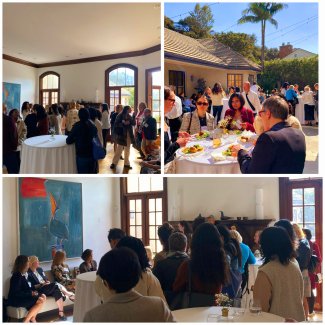Artikkelit

19.02.2025
Women in Science – equality issues in the State of California
February 11th 2025 marked the International Day for Women and Girls in Science, and was the 10th time we celebrated this day declared by the United Nations. In Los Angeles, the Finnish Consulate organized an event to discuss the gender equality issues in science, and several participants from the local Women and Science organizations joined the interesting dialogue. California has for long been a leader for innovations and scientific discoveries, and the landscape of women in science within the state reflects this pioneering spirit. The state has numerous organizations related to the topic, and the universities may have even more than one organization per school. In California, women hold about 45% of STEM degrees but make up only 28% of the workforce on those fields. Despite the clear progression in increasing the female representation and fostering inclusive environments in the academia, challenges still remain and it is important to keep up the conversation on the equality in science.
Gender Parity in Californian Universities
California has for long time been a home to world-renowned research institutions, universities, and private laboratories, attracting top female scientists from all around the globe. The state's thriving tech industry with companies like Google, Apple, and biotech giants, provides also opportunities for women to excel in R&D as well as pursue a career in tech. While women in general make up the majority in most graduate programs in California, disparities exist in fields like physical sciences and engineering, just like in every other country in the world - men still dominate on these fields and women remain underrepresented on STEM fields at both the undergraduate and faculty levels.
Californian universities have been working to address these gender disparities through programs and reforms: As an example, The University of Southern California (USC) from Los Angeles boasts an impressive 50% female enrollment in its engineering programs, showcasing a commitment to gender parity in a traditionally male-dominated field. USC first reached gender parity with their incoming first-year class of 2019. Women in Science and Engineering program at USC offers professional, academic, and social services to students who identify as women. The goal is to provide resources and overall support that will address the unique challenges that women engineers face. Similar programs aim to increase the representation and success of women in science and engineering in other universities too.
Another example from L.A. region is Caltech: Caltech achieved a historic milestone in 2024 with more than half of its incoming undergraduate class being women, first time in its 133-year old history. This achievement follows years of effort to encourage women in STEM fields, highlighted by programs like Women in STEM, which aims to inspire high school girls by promoting local female scientists. Caltech's gender parity comes 50 years after admitting its first female undergraduates in 1970. The Women in STEM –program in Caltech has grown significantly with 500 girls participating in the recent events.
Besides USC and Caltech, all the other Californian universities have their own Women in Science or STEM organizations that perform important work for the gender parity in science. In addition to the various organizations, different types of programs and initiatives have been started in California to further advance the landscape of women in science. Various mentorship programs, networking events, and special funding opportunities provide vital resources for women at all stages of their careers. In Stanford university, Julia Olivieri, the co-president of Stanford University’s Women in Mathematics, Statistics and Computational Engineering (WiMSCE) emphasized the importance of women acting together in male dominated fields. Olivieri explains that the default in academia is for men to feel more wanted and for women to doubt whether they should attend an event or speak up during a discussion. WiMSCE aims to create an environment where women can bring up issues specific to being a woman in STEM. With its many actions, California stands at the forefront of scientific advancement, and the contributions of women in science are integral to its continued success.
Challenges and Opportunities
While these above shifts represents progress, challenges remain, as women are still underrepresented in the STEM workforce, often facing discrimination and unwelcoming cultures. The gender gap in STEM fields continues to be a concern with women often less represented especially in the leadership roles and research positions all over the world. According to recent data, women in California make up only 28% of the state's tech workforce, and even fewer hold executive or board-level positions. Besides that women may experience a wage gap compared to their male counterparts. It seems common that unconscious biases can hinder women's advancement and create barriers to their success.
Besides, the equality of women in science, the theme diversity in science/STEM has been promoted a lot for the past years in California. How President Trump´s new executive orders, denying the transgender people and leading to discrimination of certain groups based on their gender identity, will affect California? The new orders conflict with the laws in California and it is difficult to see that the atmosphere in this state would suddenly change. The work towards equality in general will for sure continue. By addressing the challenges and celebrating the achievements of women and diversity in Science and STEM, the state can create a more equitable and inclusive future for all.
Sari Tojkander and Tiia Kiuru, Consulate General of Finland in Los Angeles
Photos by Tiia Kiuru: Celebrating Women in Science in Los Angeles with local academia and women in Science & STEM organizations. The dialogue on gender equality and the obstacles that women face during their academic careers was filled with multiple perspectives from scientists working on different fields.
References
https://www.latimes.com/california/story/2024-08-27/caltech-long-male-bastion-to-enroll-majority-women-for-first-time
https://viterbiadmission.usc.edu/women/
https://news.stanford.edu/stories/2020/03/recognizing-empowering-women-stem
https://losangelesgwis.wordpress.com/
https://www.awislavc.org/
https://careers.usc.edu/organizations/association-for-women-in-science/
https://libguides.calstatela.edu/c.php?g=1139534&p=8314228
https://www.latimes.com/world-nation/story/2025-01-23/trumps-rebuke-to-gender-ideology-changes-federal-policy-and-sets-up-clash-with-california
